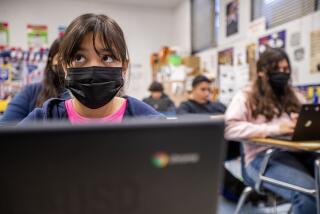Grade-School Teams Gamble on Stocks, Reap Rewards in Math
The Camarillo brokerage firm of Morgan, Carlson, Mauck & Kory depended, almost exclusively, on the performance of the high-tech industry in its 1995 fourth-quarter stock transactions.
That strategy paid off in the form of a nifty profit--albeit an imaginary one.
Mathew Morgan, Cameron Carlson, Travis Mauck and Nick Kory, fifth-grade students at Camarillo Heights Elementary School, invested a fictional $10,000 in five stocks last October and sold the stocks in December for $11,850.
The hypothetical transactions were part of the “Ticker Tape Rally,” a scholastic “Times in Education” contest administered by The Times.
Thanks to their stock market savvy and math skills, the boys finished second in the third- through eighth-grade category in the contest’s Ventura County-San Fernando Valley region, earning a real $250 for their class.
The more than 30 Camarillo students who participated were among 34,000 children in grades three through 12 involved in the program. Student teams were judged on the performance of their stocks and on their math skills--including converting fractions to decimals, determining the cost of stock shares and calculating 1% commissions.
“Math is part of everyday life,” said Mary Yee, instructor of the GATE math group at Camarillo Heights. “They had to keep a list of closing prices and convert that to money. They had a worksheet where they kept a list of the value of the stock.”
By following the market so closely, Yee said, students got a better idea of which industries are doing well and which are struggling.
“I gave them a list of a lot of different companies in a lot of different areas--food, entertainment, technology--because we wanted a diverse portfolio,” she said. “The winning group bought more technology than most, and that’s why I think they won.”
Mathew, Cameron, Travis and Nick purchased stock in Sony Corp., AT&T;, Uunet Technologies, Adobe Systems and Warnaco Inc.
Uunet, an Internet company, was the big gainer. The foursome purchased the stock at 52 points, it peaked at 90 and they sold it at 74 3/4.
“We were lucky to pick it up at a time when it was going up,” Mathew said.
The Adobe Systems stock, purchased at 58 1/4 and sold at 69 3/4, also paid off. The boys bought Sony at 47 1/2 and sold it at 55 1/8 and purchased AT&T; at 62 3/4 and sold it at 67.
Warnaco, though it was not the top performer, perhaps was the biggest surprise of the five stocks. “Nick Kory picked it. He thought it was Warner, but it’s really an underwear company,” Mathew said. “He bought it in the 20s (22 1/2) and it went up to 26 5/8.”
As a group, Yee said, her students shied away from banks because of the uncertainty created by recent mergers, leaning more toward retail outlets and airlines.
“They knew the holidays were coming up and people would be traveling,” she said. “Airlines did very well this year.” The students also found PepsiCo Inc., Coca-Cola Co., Wal-Mart Stores and K mart to be sound investments, she said.
At Our Lady of the Assumption School in Ventura, teacher Carole Martin introduced her sixth-grade class to the stock market earlier this month.
Martin divided her class of 38 into groups of about four, gave each group $2,000 in Monopoly money and instructed them to buy four stocks and chart their progress through early May. As with Yee, playing the stock market is part of Martin’s math curriculum.
“We do a lot of work with decimals, ratios and percentages in the sixth grade,” Martin said. “They try to figure out the ratio between a stock and a dividend, they figure out whether they made or lost any money each week, they keep a running tab on the stock.”
Martin began the course work with a presentation by a Merrill Lynch stockbroker, who explained what stocks are and how to read the stock exchange. When it came time to purchase the stocks, Martin said, many of her student teams chose company names with which they were familiar.
“A lot of them wanted Disney, and a lot of them liked Pepsi because they knew the name,” she said.
But unlike the Camarillo Heights students, many of those at Our Lady of the Assumption liked the prospects of financial institutions. “Interestingly enough,” Martin said, “many of them chose Wells Fargo. We did this right before the merger [with First Interstate] went through, and the students made some money.”
More to Read
Inside the business of entertainment
The Wide Shot brings you news, analysis and insights on everything from streaming wars to production — and what it all means for the future.
You may occasionally receive promotional content from the Los Angeles Times.










